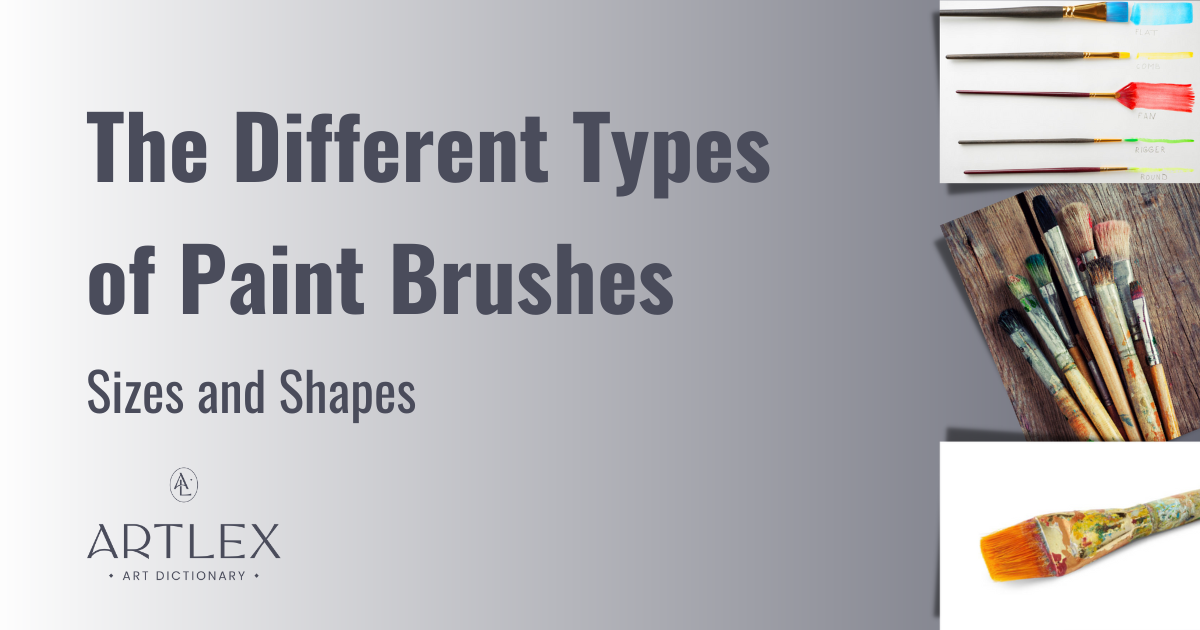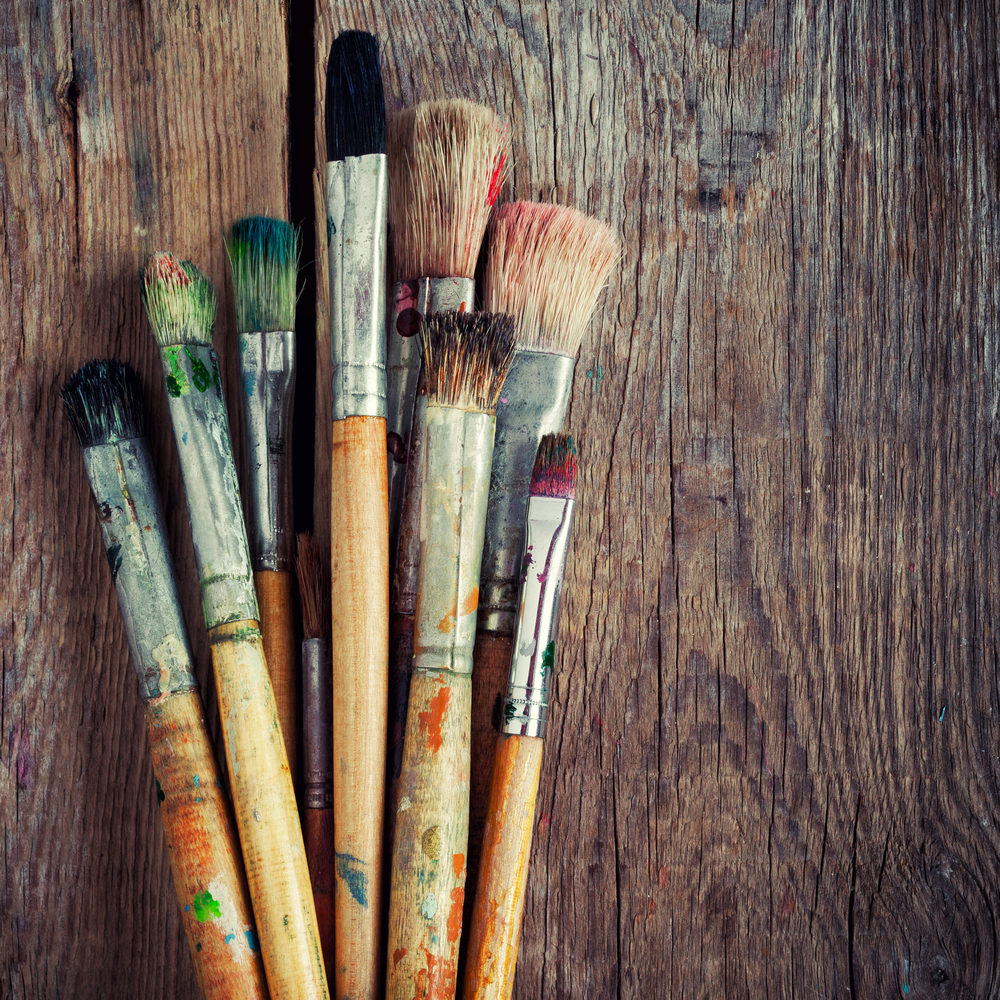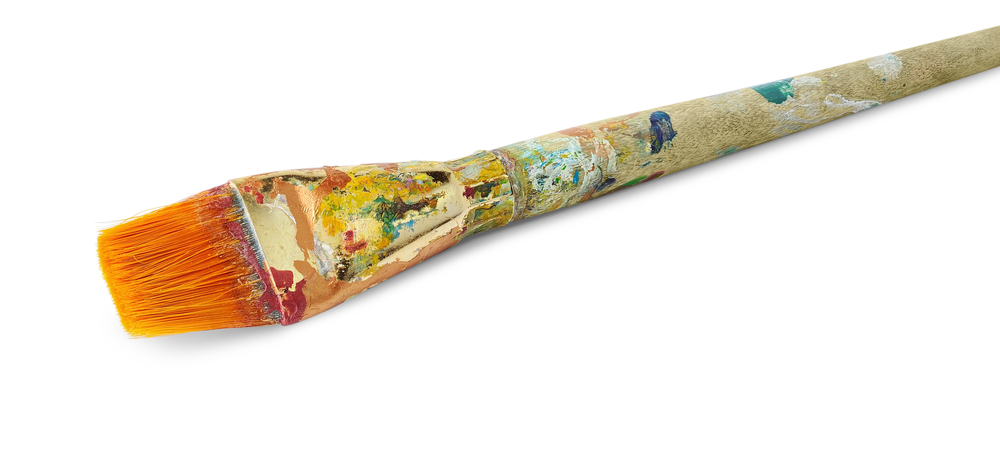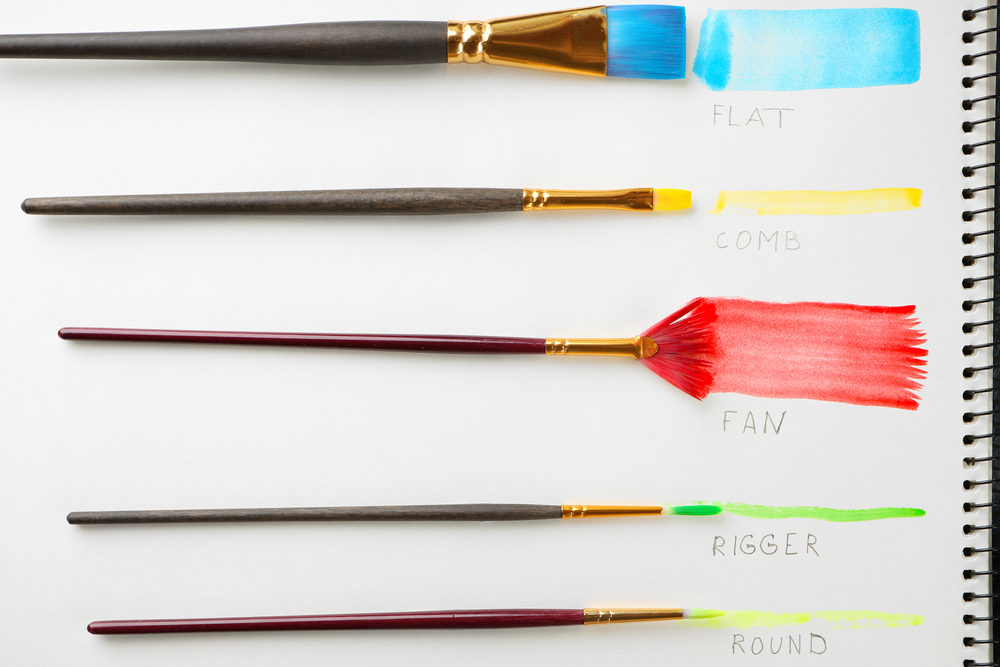
There are a dozen types of paint brushes used in art that are appropriate for different types of paint, including watercolor brushes, acrylic paint brushes, and oil-based paints. Understanding the difference between the shape, hardness, and material of the bristles can help artists turn their brush into a magic wand to produce beautiful artwork.
First, we will cover the different materials bristles can be made of, including hardness factors and which technique each shaped brush is appropriate for creating.
Note that a paintbrush consists of four parts– bristles, a ferrule, and crimp (which hold the bristles to the handle), and the wood or metal handle.
Bristle types
There are two main types of bristles: natural, made from animal fur, and synthetic, including polyester brushes. Foam brushes, while synthetic, will be covered in their own section as they are very different in makeup and usage.
Fun fact: The word “ferrule” originated, in part, from the Latin word “ferrum,” meaning iron.
Anyone who has ever purchased a cheaply made brush knows that shedding is not only annoying but can also ruin excellent artwork. Before the invention of metal ferrules in the early nineteenth century, paintbrushes were attached to a wooden stick without being entirely secure. This created a lot of shedding for earlier artists.
The invention of the ferrule helped better secure the bristles making painting clean lines or blending backgrounds easier without removing bristles from a painting. Note that most brushes can be purchased from a local art store or online.
Natural Bristles

Natural bristles consist of any bristle that comes directly from animal hair, most commonly goat, ox, hog, squirrel, or sable. Some natural hairs are made of soft bristles like sable or squirrel brushes with soft edges that are ideal for watercolor painting.
The highest quality natural brushes for watercolor are Kolinsky Sable brushes. They have fine hairs and hold water perfectly but shouldn’t be used with acrylic paints.
Like ox hair paint brushes, a hog bristle brush usually has stiff bristles packed tightly in the brush and can be used for watercolor or oil paints but should not be used with acrylic paints. Most natural hair Filbert or flat brushes are made with these hairs.
In addition, buying a wash brush made out of hog hair is ideal for larger washes due to its ability to release paint evenly. Know that even with proper care, a hog hair brush will eventually wear down.
An ox painting brush has very long bristles, and this flat brush can be used to paint kitchen cabinet doors as a finishing brush or for washes. These bristles provide fluid paint coverage, and an economical set can be found in different sizes.
Painting with a natural paint brush is a luxury worth pursuing, and although they need special care, they can last decades and are well worth the investment for serious artists.
Synthetic Bristles

Synthetic brushes are designed to imitate the qualities found in natural hair bristles without the special care required to maintain them. These brushes are excellent for acrylic paint. Artists on a budget can use them for gouache or oil-based paints for their ability to snap back quickly, keep their shape, and last years with proper care.
A synthetic brush has synthetic hairs and leaves fewer brush marks on a painting than natural hair, which is a perk. Unlike other brushes, they can be used as acrylic brushes to hold more paint or for adding subtle highlights to a still-life painting. What’s more, an acrylic wash brush can hold more paint than any other brush shape for this medium.
Foam Brushes
Unlike brushes made from bristles, foam brushes are made from one whole piece of foam. Foam brushes can be used as stencil brushes on flat surfaces or to apply paint to glassware using acrylic paints.
Brush Shapes

Brush shapes come in several shapes and sizes. There is no general sizing chart for brushes, so the best way to look for a brush, especially online, is to look at the inches or millimeters to determine if it’s a thin brush or a large paint brush.
In addition, the best size brush to buy depends on the type of painting and the medium used. Watercolors need to hold more water, so larger brushes will be optimal, while dry painting can use a range of smaller and large brushes.
Flat Brush
Generally, flat brushes are used as a wash brush and to create bold strokes. Their versatility also allows them to be used for straight edges and fine lines.
Some flat brushes have an angled or slanted tip, called angled brushes, with similar functions as a flat brush. An angled brush is primarily used for filling corners and curved strokes.
Fan Brushes vs. Flat Brushes
A fan brush, while flat, has spread hairs making this type of paint brush useful for feathering or adding texture to a painting. They also don’t have any many hairs as a flat brush.
Round Brushes
Round brushes are excellent for fine details. Round brushes have a pointed tip that helps add subtle highlights to paintings. Some, such as a rigger brush or even a pointed round brush, have the most sharply pointed tip as they are primarily used as liner brushes in oil, acrylic, or gouache painting.
A round brush is excellent for also creating thick or thin lines. For watercolor paints, round brushes are one of the most widely used for their versatility as a wash brush or their brush tip used as a liner brush for details.
Filbert Brushes
Filbert brushes have an oval-shaped end. This brush can be used for fine lines or broad strokes and is ideal for painting nature elements.
Conclusion
We hope our article describing the different types of paint brushes has been helpful. We have covered the different types of paint brushes and their various uses. We hope you better understand when to use acrylic brushes or flat, round or oval brushes for your next painting project.
